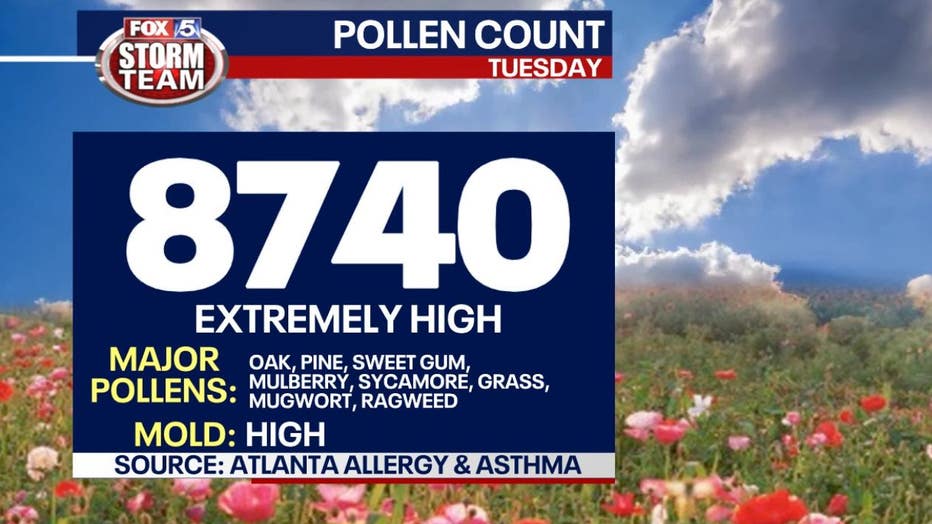Atlanta's pollen count on Tuesday third highest ever recorded in metro area
ATLANTA - If y'all thought Monday's pollen count was high, wait until you see what it is for today!
Today's pollen count is 8740, which is the third highest ever recorded in metro Atlanta (or at least since they started being recorded in 1991).

At these levels, patients with allergies – and probably people who haven't had them before – will probably experience symptoms and should take precautions. The main tree pollen contributors today are mulberry, oak, pine, sweet gum, and sycamore.
ORIGINAL STORY
Atlanta allergy sufferers, we feel you. Monday was just not your day.
The count on Monday surpassed 6,000, but believe it or not, it is not a record.
Atlanta pollen season 2024
Monday was the eighth day when the pollen count went into an extremely high range. Easter Sunday was at 5,876, but Monday’s count was at 6,033.
The past week has been the worst of the season so far, starting out on March 25 at 4,117. Only last Wednesday offered some relief with a pollen count of 9 thanks to the rain.
Mulberry, oak, pine, sweet gum, and sycamore are all in bloom, with mugwort and ragweed also contributing to the high count.
The FOX 5 Storm Team says that Tuesday's pollen count will likely also be high as the forecasted rain will not move through until late Tuesday evening.
Surviving pollen season in Georgia
Springtime in Georgia means flowers in bloom, but it also mean pollen and seasonal allergies. Here are some ways to survive this time of year.
Top 5 pollen count days in Atlanta
While Monday’s pollen count broke into the top 10, the last time one broke into the top five was March 29, 2020, with a pollen count of 8,917. Believe it or not, that was only the second-highest recorded in the 25 years the Atlanta Allergy and Asthma Center has been keeping track of the pollen count.
The top spot goes to March 20, 2012, with 9,368. That year also saw the number three spot of 8,164, set only one day earlier.
The final two spots belong to the 2013 pollen season. Number four was at 8,023 on April 11, 2023. The following day rounds out the top five at 7,809.
Allergy season arrives in Atlanta
Allergy season has arrived in Georgia. It has come earlier and strong than expected due to higher temperatures.
Tree pollen
This natural process, crucial for the reproduction of trees, involves the transfer of pollen grains from the male part of the flower, known as the anther, to the female part, the stigma. Essentially, it is the means through which trees reproduce, given their inability to move.
RELATED: Pollen counts soaring in metro Atlanta: Tips on how to survive
The role of wind and animals, particularly birds and bees, is paramount in this process. These natural elements ensure the transfer of pollen from one flower to another, allowing for the successful pollination of trees. The wind, a significant player, carries the tiny pollen grains across distances, aiding in the fertilization process across the floral community.
Pollen counts expected to rise
There is little relief coming to allergy sufferers as experts say pollen counts are expected to rise heading into April.
How do they count pollen?
Understanding the composition and volume of pollen in the air is essential, particularly for those affected by seasonal allergies. This is where pollen counting comes into play, a scientific method practiced daily at the Atlanta Allergy and Asthma clinics. Utilizing a device known as a Rotorod, pollen grains and mold spores are collected on a greased I-Rod. This device, which operates outside the clinic, rotates periodically to gather a sample of the airborne particles.
Once collected, these samples undergo a meticulous counting process in a laboratory setting reminiscent of a miniature chemistry classroom. Under the microscope, each pollen grain and spore are identified and counted, a task that requires patience and precision. Among the various shapes and sizes, pine tree pollen grains stand out for their distinctive character and are easily recognizable under microscopic examination.
This labor-intensive process is not innate; it requires specialized training and experience. The final step involves translating the microscopic counts into an understandable daily pollen count.
Inhaler prices skyrocket as pollen falls
Many patients cannot pay the high cost at the time they need their medication most. Medical professionals say some asthma and allergy sufferers are going without the medication they need.
Pollen count history in Atlanta
The practice of pollen counting by Atlanta Allergy and Asthma dates back to the early 1980s, initially serving as an internal tool for physicians to identify allergens affecting their patients. However, as awareness and the need for this information grew, so did the methods of dissemination. By the 1990s, a dedicated phone line allowed the public to access daily pollen counts, a service that has since expanded to online platforms and TV broadcasts.
This evolution from a medical necessity to a widely used public service underscores the importance of pollen counting in our daily lives, especially for those battling seasonal allergies. As trees continue their age-old ritual of pollination, the science behind pollen counting remains a vital tool in understanding and navigating the challenges of seasonal allergies.

